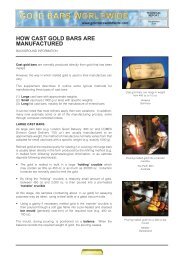Indian Gold Book:Indian Gold Book - Gold Bars Worldwide
Indian Gold Book:Indian Gold Book - Gold Bars Worldwide
Indian Gold Book:Indian Gold Book - Gold Bars Worldwide
Create successful ePaper yourself
Turn your PDF publications into a flip-book with our unique Google optimized e-Paper software.
Hallmarking charges<br />
The few hundred retailers that currently sell hallmarked jewellery either absorb the cost or increase the labour charge. For<br />
example, by Rs 5 - 15 per gramme.<br />
Authorised hallmarking centres can set their own charges. For example:<br />
Below 20 g Rs 50 per item (US$ 1.00)<br />
Above 20 g Rs 75 per item (US$ 1.50)<br />
For most retailers hallmarking is an expensive exercise, when obliged to operate competitively at low retail margins. The<br />
hallmarking cost for a pair of small earrings (2 items) would be Rs 100.<br />
A retailer is also obliged to recover the annual BIS certification fee of Rs 25,800.<br />
Exchanging old for new jewellery<br />
If the old jewellery had been bought from the same retailer.<br />
The customer is normally credited with the quoted K22 carat gold price per gramme, if it had been sold as K22 and<br />
cadmium solder had been used.<br />
If it had been sold as 22/20 (i.e. a low caratage solder had been used so that after melting the residual gold content would<br />
be 10% less than the original weight of the jewellery), the K22 carat gold price per gramme would normally be reduced by<br />
3% or more. The credited value would then be set against the price of the new jewellery.<br />
If the old jewellery had been bought from another retailer.<br />
The old jewellery would be assayed using a touchstone. As the caratage often turns out to be less than the declared<br />
caratage, an appropriately lower carat gold price would apply.<br />
In addition, there would be a further reduction: around 10 - 20% if the solder is non-cadmium, and around 8 - 10% if the<br />
solder is cadmium (or high caratage).<br />
Supplying old jewellery for refashioning into new jewellery<br />
Under this system, often used in suburban areas, small towns and villages, gold in any form (but usually accumulated old<br />
jewellery) is given to a local retailer or fabricator so that it can be refashioned into new items.<br />
The customer can hand over sufficient gold to cover all fabrication costs (i.e. labour and wastage charges). Or he can pay<br />
for the fabrication costs in rupees.<br />
The prevailing carat gold price is irrelevant to the transaction. The actual caratage of the old and new jewellery is not<br />
necessarily an issue.<br />
In rural areas in particular, this can be the cheapest way in rupee terms to obtain new gold jewellery provided the goldsmith<br />
does not reduce the caratage or retain any recoverable wastage. Customers sometimes watch him as he fabricates the new<br />
jewellery.<br />
Selling back old jewellery for cash<br />
If the old jewellery had been bought from the same retailer.<br />
Using the carat gold price, the retailer first calculates its value at the caratage at which it had originally been sold, and then<br />
reduces it according to his own declared formula. For example:<br />
Around 5% if the solder is cadmium (or high caratage).<br />
Around 10% if the solder is non-cadmium.<br />
PRICING AND PROFITABILITY<br />
If the old jewellery had been bought from another retailer.<br />
Most retailers tend not to buy back old jewellery from customers with whom they have not dealt in the past. In the event<br />
that they do, the price would tend to be low, often 10% or more below the standard bullion price.<br />
Studded gold jewellery<br />
All retailers observe that studded jewellery is more profitable than plain gold jewellery.<br />
While gross profitability (after fabrication costs) on plain gold jewellery is reported at around 10%, diamond and other<br />
studded jewellery can yield 15 - 20% and often much more.<br />
Retailers normally advise customers of the breakdown in the cost of diamond (and other precious and semi-precious)<br />
jewellery: weight of gold, cost of diamonds, labour charge and taxes.<br />
Retailers will exchange old for new diamond jewellery. The customer would usually receive the prevailing break-up value,<br />
less the labour charge. However, retailers will normally only buy back diamond jewellery if it had originally been bought<br />
from them. The price would be based on the prevailing break-up value, less 15 - 20%.<br />
Staff costs<br />
In metropolitan cities, wages for counter staff (often 20 or more in large showrooms) are reported to range from less than<br />
Rs 5,000 (US$ 100) per month up to Rs 15,000 (US$ 300).<br />
AN INTRODUCTION TO THE INDIAN GOLD MARKET 159

















